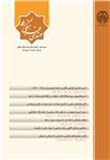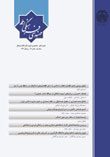فهرست مطالب

فصلنامه مهندسی فرهنگی
پیاپی 85 (پاییز 1394)
- تاریخ انتشار: 1394/08/23
- تعداد عناوین: 7
- مقالات
-
Page 10The aim of this study is social pathology of divorce, evaluating and identifying the most important individual, familial, economical, social and cultural factors as well as providing the most influential factors among the most important identified factors involved in formation of this phenomenon in the urban society of Iran.The secondary analysis has been used in this study. The statistical population has been Persian articles related to divorce in the urban society of Iran, sampling was non- random and purposeful, and the sample size has been 27 articles. The results obtained indicate that the poor life skills, deception, distrust, sexual dissatisfaction and infidelity, violence, addiction, infertility, remarriage and mental illnesses, has been the most important individual factors; family intervention, forced and inappropriate marriage has been the most important familial reasons. The most important economical factors has been economical problems, unemployment, financial independence of women, the dowry and updating of that, non-payment of alimony; negative impact of media has been the social problems; and the most important cultural factors involved in formation of divorce in urban society of Iran has been aimlessness and increase the level of expectations, fading moral and religious values, inappropriate relationship before marriage, mismatch and misunderstanding between couples, positive impression of consequences of divorce. Finally the recommendations have been offered to improve the situation.Keywords: social pathology, divorce, urban, Iran, secondary analysis
-
Page 30Sacrifice and freedom, two major issues in Islamic culture and so in this culture, is the reason of survival of Islam and the Islamic system. Islam stands on its bases and stands up against any storm based on these two axes. With the glimpse into the history of nations, we find that if a nation has enjoyed the culture of sacrifice and martyrdom, remained proud and victorious. However, for remaining the society on the permanent path of sacrifice and martyrdom or on the other hand for making the culture of sacrifice and martyrdom stable in the society without any plague, identifying the injuries and protecting from them is a must. The aim of this study is to identify the damages before the sacrifice and martyrdom by using document analysis and according to the statements of Supreme leader; then seeking to protect them from damages by providing solutions, so that the pure culture of sacrifice and martyrdom remain protected and strong. The research question is that what are the damages before the culture of sacrifice and martyrdom from the perspective of Supreme Leader and what can be the strategies for protecting them?Keywords: martyrdom, martyr, sacrifice, Ayatollah Ali Khamenei, damages, strategies, the principles of religion
-
Page 50In criminology viewpoint, some of places and some special times which have special sanctity avoid people attitude towards social perversions. The aim of the article is to study positive functions of religious ceremonies in prevention of youngsters attitude towards addiction and it also study functions of religious places toward drugs among young people who attend this religious ceremonies in science of criminology viewpoint.Method272 people were selected randomly among male university students that filled out a questionnaire to identify people who are at risk for addiction. Findings: findings revealed that both people who attend religious ceremonies and those who dont attend such ceremonies have considerable difference being at risk for addiction. Also coefficients of regression model are meaningful in two variables and negative coefficients of regression model shows that presence and continuous activities in religious ceremonies decrease the threat of being at risk for addiction among youngsters and presence and beginning of their participation in religious ceremonies in their childhood reduce the risk of using drugs among youngsters. Discussion andConclusionnecessary preplanning to attract youngsters through raising the quality of content of speeches and holding entertaining programs and educational classes and etc in these ceremonies increase their presence and continuous participation in these programs which can be a notable factor to prevent youngsters attitude towards drugs.Keywords: religious ceremonies, youngster's attitude towards drugs, prevention, social groups
-
Page 72The study on Mr. Tabatabaees viewpoint about principles of political justice and extraction, principles and methods of global citizen training based on that, is the mail purpose of the article and to achieve the objectives of the article logical deduction method is used. Considering conditions of globalization which caused to notice global citizen training and one of the main components of global citizen is to participate in social and political field along with expansion of democracy and fulfillment of political justice; but fulfillment of political justice in religious approach is different from nonreligious approach. Therefore, global citizen training along with political justice based on religious approach, has its own principles and methods. Thus, considering Mr. Tabatabaees critiques of western democracy; such as obeying the will of majority, dominance of feelings and earthly pleasures and to let human beings to appeal each ideological and moral systems; he believes one of the important principles of political justice is monotheism. Based on this principle, rudiments like: chasing the truth, freedom, spiritual freedom and religious democracy, is comprehended and according these principles, methods like: defense of true discourse, raising the spirit of chasing the truth, planning to fulfill the discourse, preparing the atmosphere for reviewing, recognizing the right to freedom of speech, criticism, self-purification, following virtue, respecting public opinions, intervening in determining our destiny, have perceived.Keywords: globalization, global citizen training, political justice, Mr. Tabatabaee Iranian religious clergyman
-
Page 92Islamic revolution was Cultural Revolution more than any other things; but by passage of three decades of victory of Islamic revolution, the cultural state of society has fair distance with genuine Islamic culture in experts point of view. Achieving a society based on Islamic culture and values will not be fulfilled if only by participation of the whole society and to take enjoining good and forbidding wrong point into consideration. Therefore, the article has studied the relations between cultural activities and duty of enjoining good and forbidding wrong using religious and sociological resources. The results of the paper has revealed that the duty of admonishing fellow believers to do the right and avoiding sins does not contain face to face activities and in a direct connections with fellow believers and indirect messages or public messages can be perceived as religious command and prohibition. Therefore this article tries to encourage religious society to be present and to organize cultural activities voluntarily and in such religious duty role, by introduction of Cultural activity as admonishing fellow believers to do right and to avoid sin, by preparing the addressee.Keywords: cultural activity, enjoining good, forbidding wrong, culture, language, communications
-
Page 109The article is following a model to achieve a world without any violence. According to this, it is presenting cultural synergy model as a solution to decrease violence in a various communities. By studying the tensions and violence in different parts of the world, this point became more considerable that the root of all these conflicts is in the differences between people, nationalities, religions and different cultures. Discrimination, prejudgment, stereotyping and cultural bias, nation-oriented and one-sided point of view, being uninformed about existing differences among cultures and ignore cultural diversity, not to stand and rejection of the differences among cultures, non-commitment to achieve peace and decrease of violence, not being capable of communicating between different cultures, lack of intelligence and cultural creativity are reasons which can cause to violence among different cultures. Cultural synergy model that can smoothen the path of global society movement to achieve a world without aggression, have four strategic, social, cultural and mastery dimensions that by fulfillment of components of the clear and joint cultural goals, effective cultural leadership, to have commitment to joint cultural objectives, social trust, intercultural connections, intercultural discourse, cultural intelligence, cultural creativity cause to the intercultural synergy and decrease aggression and help to achieve peace.Keywords: violence, peace, culture, cultural synergy
-
Page 125The usage of discussions related to organizational-social responsibilities in different service and manufacturing sections in issues such as ethics violations, financial fraud, non-alignment, moral abnormalities, discussions related to profitability, the weakness of processes and accounting supervision are much more taken into considerations. This issue can significantly enhance the stakeholders or customers` satisfaction from different institutions and can increase sales and profitability. In this regard, according to the numerous scientific observations and research, it has been revealed that by the focus and attention of officials, managers and planners of organizations to the organizational-social responsibilities, the organizational goals can be achieved more desirably and as a consequence of that the organizational effectiveness will increase. The aim of this article is to study and determine effective factors on improvement and strength of organizational-social responsibilities, emphasizing on the importance and position of them as well as determining the relationship between organizational-social responsibilities and organizational effectiveness. The results of this study indicate that the relationship between improvement and promotion of organizationalsocial responsibilities with the realization of organizational goals in the manufacturing and service sectors has been confirmed in the national and international levels. Furthermore, it has been found that there is not only positive and strong relationship between both these two variable (social responsibilities and organizational effectiveness) but also there is positive and considerable relationship between social- organizational responsibilities factors with the effective components such as: customers` mental image, innovation and creativity, commitment and ethics of human resources, costumers ` satisfaction, sales or profitability in the organization.Keywords: organizational_social responsibilities_organizational effectiveness_customer's mental image_creativity_staff s morality_customer's satisfaction_sale_profitability


